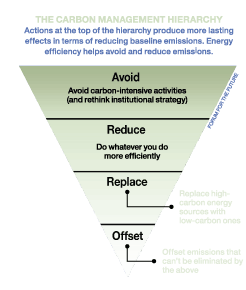A Plan to Reduce Carbon Dioxide Emissions
There are about as many paths toward carbon emissions reduction as there are reasons for an organization to undertake a commitment itself. But experts say that some paths are better than others, and there are some definite steps organizations should take in a particular order to avoid getting lost. First and foremost is simply to make every building as energy efficient as possible.
“Energy efficiency is the key,” says Keri Enright-Kato, sustainability project manager for the Office of Sustainability at Yale University. “You look at the hierarchy of strategies, and that’s first.”
For most organizations, indirect emissions (or Scope 2, as classified by the Greenhouse Gas Protocol) make up 80 to 90 percent of their carbon footprint. Scope 2 emissions are generated from the production of electricity used by facilities. So when mapping out a plan for greenhouse gas emissions reductions, up to and including neutrality, organizations should make every effort to avoid indirect emissions by reducing energy and natural gas use.
Carbon offsets are often purchased to cover Scope 1 emissions from backup generators or other direct emissions. This, say experts, is the proper use for offsets — to retroactively make up for emissions that can’t be reduced. Offsets should not be viewed as a bailout that can allow organizations to emit at will and then simply pay for their emissions. Organizations may also purchase renewable energy certificates (RECs) to illustrate that a portion of their energy is generated from renewable sources.
Energy efficiency is the most cost-effective emissions reduction strategy, both for the cost associated with the avoided energy itself, but also because it reduces the cost of almost any other strategy that can account for or neutralize an organization’s emissions. For example, if an organization is purchasing RECs to make up for its “dirty” fossil fuel-generated energy, the less energy the organization uses, the fewer RECs it needs to purchase and the more money it saves.
Organizations that wish to begin carbon reduction goals should first use the principles spelled out in the Greenhouse Gas Protocol to begin a greenhouse gas inventory. Determine all the parts— from backup generators to lighting loads — that contribute to the organization’s carbon footprint.
“The hardest part is actually starting,” says David Borchardt, director of sustainable development with The Tower Companies. “Collecting all the data is difficult because you have to make sure you have all the little pieces. We forgot about our parking lot lighting, and we didn’t have a bill for that.”
Another challenge is organizing disparate departments under the umbrella of the same greenhouse gas reduction goals, a process which may fall outside the purview of facilities.
“You have to have governance in place to allow for revenue sharing between departments,” says Mark Newton, senior manager for environmental sustainability at Dell. “You need a lock-step approach to set priorities for the organization, but link individual business units to corporate strategies.”
One approach may be to set carbon budgets for each business unit, and then develop an internal cap and trade program among business units.
Experts who have undertaken greenhouse gas emissions reduction say that, while starting may be tough, it’s better to get started now while reductions are still voluntary. On April 17, EPA declared that greenhouse gases contribute to air pollution and may pose health hazards. Many see this landmark announcement — a result of a nine-year study — as yet another step in the direction of some sort of carbon emissions legislation.
“You need to look at carbon reduction as a risk management strategy,” says Linda Hunter, director of energy services for Tetra Tech, a carbon management consulting firm. “The important thing is to act now.”
Fortunately, there is help at hand. EPA’s Climate Leaders program helps organizations inventory their carbon footprint and then set greenhouse gas emissions reductions goals.
“We analyze business as usual and then ask them to propose a goal that is aggressive compared to business as usual,” says Deb Berlin, communications director for Climate Leaders. The organization also offers resources, tools, and technical assistance to organizations in inventorying emissions, setting goals, and ultimately reducing emissions to hit those goals.


Related Topics:














